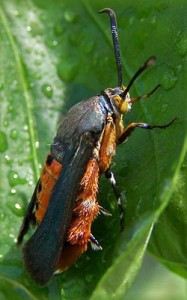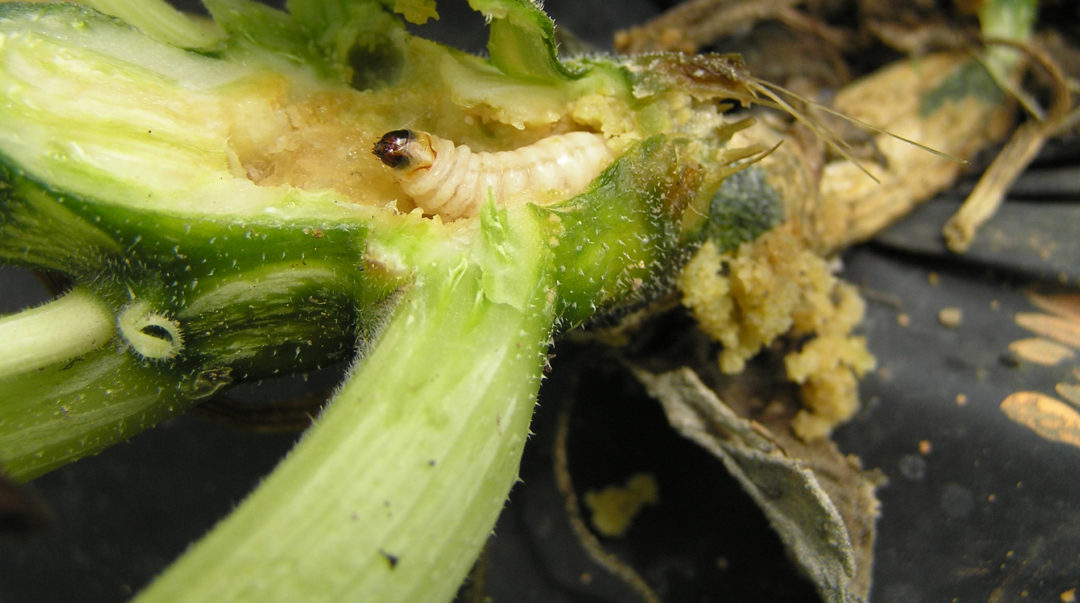You might have fallen victim to the Squash Vine Borer, without knowing how they get inside your squash plants, or where they come from. You might not have even been aware they are there until your vines have wilted and died. The Squash Vine Borer attacks cucumbers, gourds, pumpkins, melons and both winter and summer squashes. Blue and Butternut squash seem to be the most resistant, but Hubbard squash seems to be the castle most preferred by this voracious pest.
Recognizing the Squash Vine Borer Moth
 So, how do you identify the problem to begin with? The best way is to be aware of what to look for. As your squash-like plants are just about to blossom, you may notice wasps flying around your vegetable garden, paying particular attention to your squash, melons or cucumbers. Look closely; these wasps may actually be the moth that lays the eggs of the squash vine borer. They will look somewhat like a giant hornet, having a wing span of about 1.5 inches. The wings will be translucent, but colored in shades of orange and black. These female moths will have a bright orange or red and black abdomen and femurs. They can be quite elusive, prefer daytime flight, are rather noisy and will lay their eggs at the base of your plants, right on the soil. In the south, this will usually occur sometime in April or May, but it may happen later in the north, normally in June and July. The eggs will be flat, brown circles about 1/10 inch across and nearly impossible to see.
So, how do you identify the problem to begin with? The best way is to be aware of what to look for. As your squash-like plants are just about to blossom, you may notice wasps flying around your vegetable garden, paying particular attention to your squash, melons or cucumbers. Look closely; these wasps may actually be the moth that lays the eggs of the squash vine borer. They will look somewhat like a giant hornet, having a wing span of about 1.5 inches. The wings will be translucent, but colored in shades of orange and black. These female moths will have a bright orange or red and black abdomen and femurs. They can be quite elusive, prefer daytime flight, are rather noisy and will lay their eggs at the base of your plants, right on the soil. In the south, this will usually occur sometime in April or May, but it may happen later in the north, normally in June and July. The eggs will be flat, brown circles about 1/10 inch across and nearly impossible to see.
The Destructive Squash Vine Borer Larvae
In one to two weeks, depending upon the heat and weather, the eggs will hatch and become larvae. The larvae are grub-like, about an inch long, white with a dark brown head and itty bitty brown legs. They bore into the stems of your plants and are gluttonous eaters, which is what ultimately kills your plants. Inspect the stems about an  inch above the soil level for tiny holes through which the larvae have entered. You may even see a yellowish saw-dust looking material near the hole or at the base of your plants. You can confirm their presence further by using a knife to make a slit lengthwise along the stem, from the bore hole and about an inch up. You will see the worm and more of the yellowish excrement inside the stem. At this point you can kill the worms with the knife blade and then mound soil up above the wound to encourage root growth along that particular section of the stem. Be aware though, that this method will only work at the very earliest stages of infestation and can be quite time-consuming and messy.
inch above the soil level for tiny holes through which the larvae have entered. You may even see a yellowish saw-dust looking material near the hole or at the base of your plants. You can confirm their presence further by using a knife to make a slit lengthwise along the stem, from the bore hole and about an inch up. You will see the worm and more of the yellowish excrement inside the stem. At this point you can kill the worms with the knife blade and then mound soil up above the wound to encourage root growth along that particular section of the stem. Be aware though, that this method will only work at the very earliest stages of infestation and can be quite time-consuming and messy.
Perpetuating Their Life Cycle
Once the larvae have matured, they can leave the insides of your plants’ stems and start feasting on the maturing fruit. They will finally mature to the point where they leave the plant, burrow into the soil and spin a mahogany brown cocoon in which to hibernate until the following spring when the orange, red and black moths will appear once again.
Control with Food Grade Diatomaceous Earth
Now, how do you control them? I’m sure you’ve heard the old saying, an ounce of prevention is worth a pound of cure; and in this case, that is SO true. Food Grade Diatomaceous Earth is one of the best preventive measures. Diatomaceous Earth (DE) is a naturally occurring, organic pesticide in dust form that cuts the exoskeletons of the moths, both as they emerge from the soil and as they land to lay their eggs. A little goes a long, long way and it is easy to apply, especially if using a duster designed for DE, but the best part is that Food Grade Diatomaceous Earth will also deter and destroy a whole host of other garden pests with absolutely no ill-effects on your family, your pets or the environment. Dust with DE from the ground up, paying special attention to the undersides of the leaves, as this is where most insects will lay their eggs. Application is recommended once a month or after a very heavy rain, but as long as dust is evident at the base of the plants and under the leaves, you do not have to reapply heavily.
Deterring with a Plant & Seed Blanket
If, on the other hand, you’ve never had Squash Vine Borers in your garden, you may be able to get away with a simple cover. This lightweight, breathable blanket can be applied when you seed or first transplant seedlings. It allows essential air and moisture to reach your growing plants, but will prevent the Squash Borer moth from being able to lay her eggs. Just apply the blanket over your seed bed or transplants with plenty of slack to allow for plant growth and blooming. The ends and sides can be held down with garden stakes or with loose soil. Once the blossoms have wilted, giving way to the fruit, it should be safe to remove the plant and seed blanket.
you may be able to get away with a simple cover. This lightweight, breathable blanket can be applied when you seed or first transplant seedlings. It allows essential air and moisture to reach your growing plants, but will prevent the Squash Borer moth from being able to lay her eggs. Just apply the blanket over your seed bed or transplants with plenty of slack to allow for plant growth and blooming. The ends and sides can be held down with garden stakes or with loose soil. Once the blossoms have wilted, giving way to the fruit, it should be safe to remove the plant and seed blanket.
Use Hot Pepper Wax Spray to Make Their Lives Miserable
Another preventative measure that is used very successfully is Hot Pepper Wax Spray. Made by combining capsaicin (what makes cayenne peppers hot) and a thin, food grade paraffin, the spray coats your plants with an unpleasantly irritating liquid that stays in place by being bound to the waxy paraffin. Apply to the bottom couple of inches of the stems to prevent the larvae from boring as they hatch, or apply to the whole plant, including the undersides of the leaves, to also deter aphids, spider mites, whiteflies, lace bugs, leafhoppers, thrips and many more pests. Be aware though, that when checking growth progress, weeding or harvesting your produce, the capsaicin can transfer to your skin and be quite irritating, especially if you have open wounds or you rub your eyes. It will sting, but warm water will wash the residue away. Young children who put their hands in their mouths will also experience an unpleasant heat.
Kill Them with BT
Finally, for the very worst infestations and to completely prevent the larvae from spinning cocoons that will produce Squash Vine Borer moths next year, we recommend using Bacillus Thuringiensis, a.k.a. BT. BT occurs naturally and is a soil-borne organism that has the ability to control squash vine borers and other insects that are in the worm or caterpillar stage of development. It can be applied to the foliage of plants on which larvae are feeding, but it can also be used as an injection to the insides of the stems to destroy the borers. Bacillus Thuringiensis effectively paralyzes the digestive tract of the larvae, which means they can’t feed anymore, which causes them to die. BT is effectively used as a pre-emptive measure, when injected into your plants right after the first blossoms appear and then again in a week to 10 days. You simply mix it as you normally would for external application, and then use a disposable syringe that you can buy at any drug store. You can also use a wood worker’s glue injector, but be sure to rinse the needle with a mixture of chlorine bleach and water between injections in order to prevent possible cross-contamination of other diseases that you are not yet aware of. Mix the BT just prior to use and inject the stem about 1.5″ above the soil line. The borers will eat it as they first start to feed, causing them to die. The recommended amount is about 1cc of BT for each injection. It will wash the hollow interior of the stem, but will flow back out of the stem through the injection site if you use too much.
Good luck and happy gardening, everyone!





7 Comments
Protect Against Bacterial WiltIn Advance! | Garden Harvest Supply
February 27, 2014 at 10:37 am[…] One noteSimilar symptoms that can affect cucurbit vines are caused by the squash vine borer. Unlike entire groups of leaves or vines wilting, the damage is usually limited to single vines on plants that are otherwise healthy. The squash vine borer is a whitish-colored caterpillar with a brown head and can be found inside the stems of the wilted vines. You may also see a moist, sawdust-looking material around the runners infested by this pest. Cucumbers and melons are not usually first on their list of preferred veggies, though. Squash vine borers will go for squash, zucchini, pumpkins and gourds first; their favorite is Hubbard squash, while they will avoid butternut squash. If plants other than your cucumbers and cantaloupe are wilting, then the squash vine borer may be the perpetrator, not the cucumber beetle. You can look to this article for ways of controlling or deterring this pest: Invasion of the Squash Vine Borer […]
Mary Sergiacomi
August 13, 2015 at 11:13 amThis information has been so helpful, and although it’s too late for me to apply it this year, I look forward to being armed next year to fight against these pests who have deprived me of enjoying the luscious zucchinis and yellow squash from Garden Harvest Supply. Btw, that’s not meant as a plug for the company, I sincerely appreciate the help I’ve been given to counteract the damage caused by those pesky pests.
Thanks Garden Harvest Supply,
Mary Sergiacomi
jstutzman
August 13, 2015 at 3:04 pmMary we are glad to help. Good luck next season! GHS
Shelly Moore
August 29, 2015 at 10:30 pmHelpful! I have had infestations the past two summers. Is there something I need to do to the soil to prevent the borer eggs from living in there over the winter?
jstutzman
August 31, 2015 at 12:22 pmShelly, you cannot put anything into the soil to stop the eggs from hatching. That is why it is imperative to move to another location each season. It is recommended to wait at least 2 seasons before going back to the same spot. Good luck! GHS
Sue Sidzina
June 18, 2020 at 8:38 amI have worked the top few inches of the soil late fall and found some of the cocoons. I think that and exposing them to the cold and maybe birds could help. I have missed a few finding them in neighboring beds where they had infested a leaf stem. I’m hoping they’ll be done laying eggs in the next week or two so I can uncover my plants for a month before they begin again!
GrowJoy Plants
September 7, 2020 at 5:35 pmSue, that sounds like a good plan. Keep us posted on how it works out!